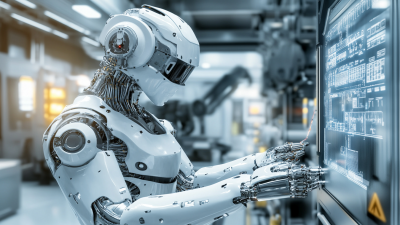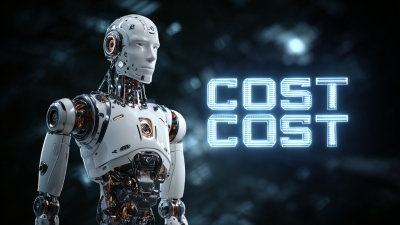

14, Raghava Enclave, Transport Road, Secunderabad, Hyderabad (500009)
©2024 All Rights Reserved by excitechrobot.com
As industries across the globe rapidly evolve, the integration of innovative robotics solutions has emerged as a pivotal force in transforming operational efficiency and productivity. According to a report by the International Federation of Robotics, the global industrial robot market is projected to reach $114 billion by 2025, with a significant annual growth rate of 26%. This trend signifies not only the increasing reliance on robotics in manufacturing but also highlights their expanding roles in sectors such as healthcare, agriculture, and logistics. Innovative robotics solutions are not merely futuristic concepts; they are current necessities reshaping workflows, enhancing precision, and driving cost reductions.

As we delve into the real-world applications that exemplify these advancements, it becomes clear that the future of robotics is intertwined with the development of intelligent systems designed to tackle complex challenges across various industries.
Innovative robotics solutions are revolutionizing various industries by enhancing efficiency, accuracy, and safety. At the core of this transformation is the integration of advanced technologies such as artificial intelligence, machine learning, and the Internet of Things (IoT). According to a report by the International Federation of Robotics (IFR), the global industrial robotics market is expected to grow to $70 billion by 2026, driven by the demand for automation in manufacturing and logistics. These advancements not only streamline operations but also reduce human error, leading to increased productivity.
To successfully implement these innovative robotics solutions, it is crucial for businesses to adopt a strategic approach. Here are a few tips: First, assess your specific needs and workflows to identify areas where robotics can provide the most significant impact. Next, invest in training for your workforce to ensure seamless integration of robots into existing teams. Lastly, keep abreast of technological advancements and adapt your strategies accordingly, as the robotics landscape is continuously evolving.
As industries like healthcare, agriculture, and retail continue to adopt robotic technologies, the advantages are becoming clear. For example, the McKinsey Global Institute reports that automation could elevate productivity by 0.8% to 1.4% annually, underscoring the importance of embracing innovative robotics solutions for long-term growth and competitiveness.
In recent years, robotics has emerged as a transformative force across various industries, paving the way for unprecedented efficiency and innovation. Manufacturing is one of the key sectors experiencing this revolution. By integrating robotics into production lines, companies can achieve higher accuracy and speed while minimizing human error. This shift not only enhances output but also allows workers to focus on more complex tasks, ultimately driving overall productivity.
In the healthcare industry, robotics is reshaping patient care and surgical procedures. Robotic-assisted surgeries provide surgeons with enhanced precision, resulting in less invasive procedures and quicker recovery times for patients. Moreover, robotic systems are increasingly being utilized in care facilities to assist with daily tasks, allowing healthcare professionals to dedicate more time to patient interaction.
**Tip:** Businesses considering adopting robotic solutions should start with a clear identification of areas where automation can provide the most benefit. Conducting a pilot program allows organizations to assess the integration process and make necessary adjustments before a full implementation.
**Tip:** In healthcare, training staff to work alongside robotic systems is crucial. Ensuring that all team members are comfortable with new technologies fosters a collaborative environment that maximizes the effectiveness of robotics while maintaining a high standard of patient care.
This chart illustrates the investment in robotics across key industries. Manufacturing leads with significant investment, showcasing the transformative impact of robotics in enhancing efficiency and productivity, followed by Healthcare, Agriculture, Logistics, and Construction.
In recent years, robotics has made significant strides in various industries, showcasing its potential to revolutionize traditional practices. A compelling case study is the use of robotics in the agriculture sector, where autonomous drones are transforming crop monitoring and management. These drones utilize advanced imaging technology to assess crop health, identify pest infestations, and optimize irrigation practices. By providing farmers with precise data, these robotic solutions enable them to make informed decisions, increase yields, and reduce resource waste.
Another fascinating application is found in the healthcare industry, where surgical robots are enhancing precision in complex procedures. For instance, robotic-assisted surgeries allow surgeons to perform minimally invasive operations with greater accuracy and control. This not only shortens recovery times for patients but also minimizes the risk of complications. As hospitals continue to adopt these innovative technologies, the overall quality of care improves, demonstrating the profound impact of robotics on medical practices.
| Industry | Application | Benefits | Case Study Details |
|---|---|---|---|
| Manufacturing | Automated Assembly Lines | Increased Efficiency, Reduced Labor Costs | Implementation of robotic arms for assembly tasks leading to a 30% increase in output. |
| Healthcare | Surgical Robots | Precision, Minimally Invasive Procedures | Enhanced surgical outcomes with reduced recovery times for patients. |
| Agriculture | Autonomous Harvesters | Higher Yield, Reduced Waste | Streamlined harvesting process leading to an increase in crop yield by 20%. |
| Logistics | Warehouse Robots | Improved Inventory Management, Reduced Errors | Robotic solutions that scanned and sorted items with 99% accuracy. |
| Retail | Customer Service Robots | Enhanced Customer Experience, 24/7 Service | Robots that guided customers and provided product information in stores. |
Robotics is revolutionizing various sectors, particularly in manufacturing, logistics, and automotive industries. With advancements in AI and automation technologies, organizations are witnessing significant improvements in efficiency and productivity. For instance, predictive maintenance powered by AI enables manufacturers to anticipate equipment failures before they occur. This not only reduces downtime but also enhances overall production efficiency, leading to faster turnaround times and increased output. Recent studies show that companies integrating AI in manufacturing processes can achieve up to 20% cost savings and 30% increases in production efficiency.
In the logistics sector, automation solutions such as autonomous robots are streamlining warehouse operations, facilitating faster order fulfillment. Robots reduce human error and ensure precise handling of goods, contributing to a more efficient supply chain. Similarly, in the automotive industry, advanced robotics is adapting production lines to achieve higher precision and flexibility, making it easier to meet consumer demands while minimizing waste.
Tip: To maximize the benefits of robotics in your organization, consider investing in training for your workforce. Upskilling employees to work alongside robotic systems can enhance collaboration and ensure smooth integration of technology into existing workflows. Additionally, staying updated on the latest trends in robotics and AI will help your business remain competitive in an evolving market.
The landscape of robotics is rapidly evolving, driven by advancements in artificial intelligence, machine learning, and automation technologies. According to a report by the International Federation of Robotics (IFR), the global robotics market is projected to reach $510 billion by 2025, indicating a robust growth rate of over 26% annually. This surge is fueled by industries seeking innovative solutions to enhance productivity and efficiency, particularly in manufacturing, logistics, and healthcare.
Emerging trends are paving the way for the next generation of robotics solutions. Collaborative robots, or cobots, are set to redefine human-robot interactions on the factory floor. A study by McKinsey highlights that the adoption of cobots can lead to a 20-30% increase in productivity. Additionally, advancements in autonomous mobile robots (AMRs) are transforming supply chain operations. It’s estimated that the AMR market will grow from $1.4 billion in 2021 to $11.8 billion by 2026, reflecting a compound annual growth rate (CAGR) of 53%. Such innovations not only optimize operational efficiencies but also reshape workforce dynamics, creating a future where humans and robots work side by side to push industries toward greater innovation.






